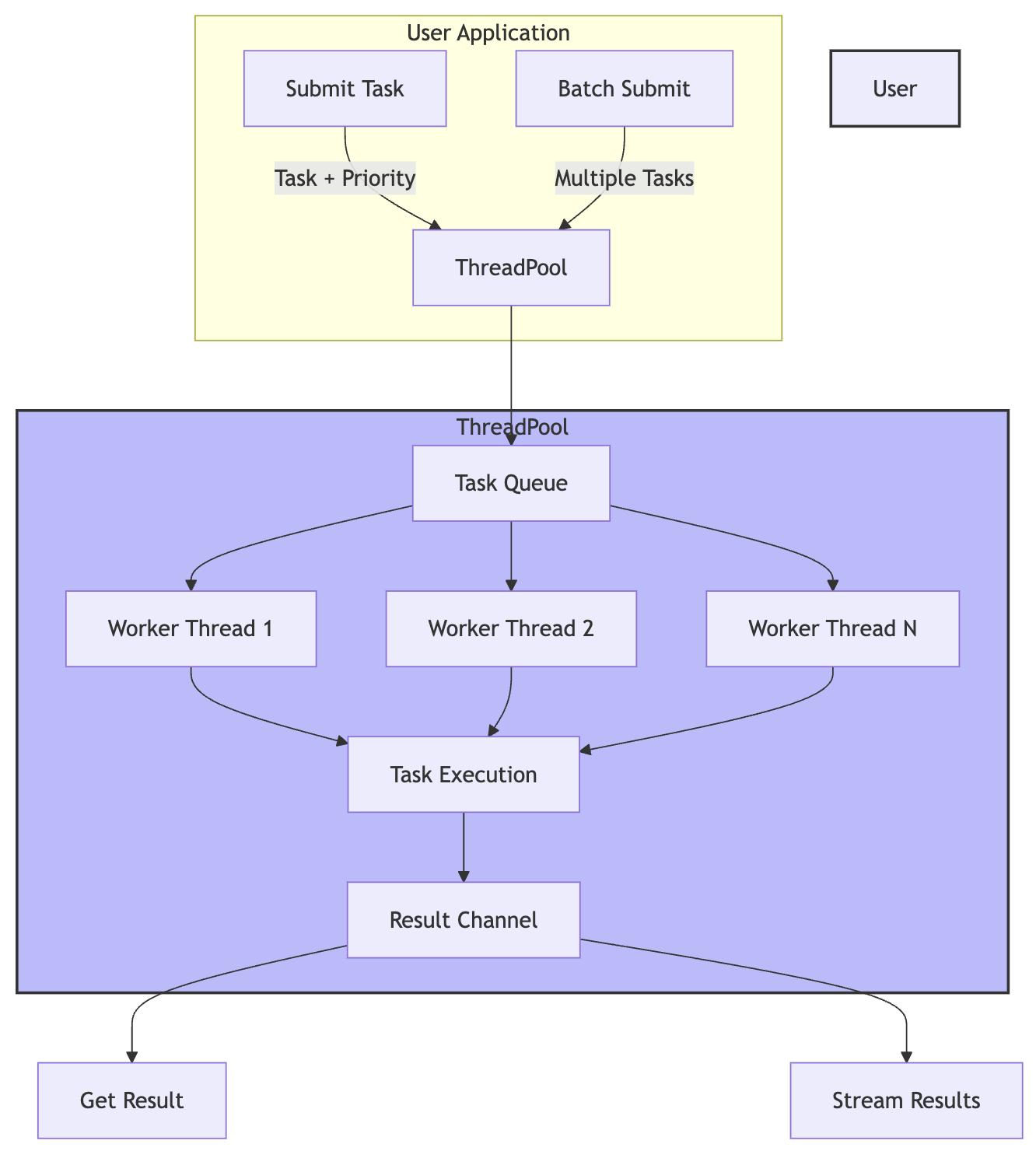深入理解 tokio-fusion:为 Rust 异步任务而生的线程池引擎
- King
- 发布于 2025-06-04 09:48
- 阅读 1914
在高性能异步系统中,任务的调度和执行策略对整体吞吐量与响应延迟起着决定性作用。Tokio是Rust社区主流的异步运行时之一,拥有成熟的任务系统和I/O模型。然而,当我们需要对任务调度进行更细粒度的控制,比如优先级、批处理、任务分组或返回结果流时,Tokio的原生抽象就显得不够灵活。
在高性能异步系统中,任务的调度和执行策略对整体吞吐量与响应延迟起着决定性作用。Tokio 是 Rust 社区主流的异步运行时之一,拥有成熟的任务系统和 I/O 模型。
然而,当我们需要对任务调度进行更细粒度的控制,比如优先级、批处理、任务分组或返回结果流时,Tokio 的原生抽象就显得不够灵活。
为此,tokio-fusion 提供了一种融合了 Tokio executor、异步任务建模与线程池调度的新机制。 本文将深入剖析 tokio-fusion 的架构、核心组件与设计思想。
一、设计目标
tokio-fusion 的目标是提供:
- 统一的异步任务抽象,具备优先级、任务 ID 与结果类型支持;
- 线程池调度器,支持可配置的 worker 数量与队列大小;
- 任务执行结果流式可读,无需额外的 channel 或 handle 拼接;
- 高并发安全,使用
Arc<ThreadPool>可在多个任务间安全共享; - 灵活集成,可作为 tokio 子系统使用,也可嵌入到现有 async 应用中。
二、核心架构与组件

架构由以下几部分组成:
1. ThreadPool
ThreadPool 是 tokio-fusion 的调度引擎,它持有一个 tokio::runtime::Runtime 并在内部维护一个多生产者单消费者(MPSC)的任务队列,支持配置以下参数:
worker_threads:线程池中的 worker 数量;queue_capacity:内部任务通道的缓冲大小;- 支持无界模式(默认)或有限容量阻塞提交。
它的主要职责包括:
- 接收用户提交的异步任务;
- 根据优先级对任务进行排序(future roadmap);
- 派发任务到 Tokio runtime 执行;
- 提供返回结果的
ResultHandle<T>。
2. Task<T>
Task<T> 是 tokio-fusion 的核心任务抽象,定义为:
pub struct Task<T> {
pub fut: BoxFuture<'static, ThreadPoolResult<T>>,
pub priority: usize,
...
}该结构封装了:
- 一个异步函数
fut,必须返回Result<T, ThreadPoolError>; - 一个优先级值;
- 可选的任务 ID 或 tracing context(future 支持);
3. ResultHandle<T>
任务提交成功后,会返回一个 ResultHandle<T>,支持异步地 .await_result() 来获取结果。这避免了开发者自己管理 oneshot 通道或回调闭包。
内部使用 tokio::sync::oneshot 来桥接任务执行结果和用户逻辑,确保类型安全。
三、运行机制详解
以单个任务的提交流程为例:
let thread_pool = Arc::new(ThreadPool::default());
let task = Task::new(async {
// 业务逻辑
Ok(compute_something().await)
}, 1); // priority
let handle = thread_pool.submit(task).await.unwrap();
let result = handle.await_result().await;执行流程图如下:
- 用户通过
submit()提交Task<T>; ThreadPool将其包装进调度队列;- 后台
Runtime中的 worker 消费队列并 spawn; - Task 执行完成后,通过
oneshot::Sender传回结果; - 用户通过
ResultHandle.await_result()异步获取最终结果。
四、高级特性与扩展点
1. 批量任务提交
你可一次性提交多个 Task<T>,并获取多个 ResultHandle<T>,配合 FuturesUnordered 可实现流式聚合处理。
let thread_pool = Arc::new(ThreadPool::default());
let mut batch = BatchExecutor::new(Arc::clone(&thread_pool));
// Add tasks to the batch
for i in 0..5 {
batch.add_task(my_task(i), i);
}
// Execute all tasks and collect results
let results = batch.execute().await;
// Or stream results as they complete
let mut stream = batch.execute_stream().await;
while let Some(result) = stream.next().await {
println!("Got result: {:?}", result);
}2. 动态任务优先级(计划中)
目前 priority 字段尚未集成到队列排序中,但未来将支持 heap-based 优先队列,使得高优任务能先执行。
3. 自定义错误类型
通过 ThreadPoolResult<T> 和 ThreadPoolError,你可以对运行时错误进行分类,例如队列满、执行 panic、提前 drop 等。
五、使用场景
tokio-fusion 非常适合以下几类应用:
- 异步任务密集系统:如区块链爬虫、日志处理、爬虫调度等;
- 需跨 Tokio 上下文复用线程池的系统;
- 构建 DSL 批处理框架:如将多个业务任务封装成
Task<T>提交执行; - 对任务控制粒度要求高的服务层。
六、对比现有方案
| 特性 | tokio::spawn | rayon/futures | tokio-fusion |
|---|---|---|---|
| 支持 async task | ✅ | 部分 | ✅ |
| 支持线程池控制 | ❌(由 runtime 控) | ❌(线程绑定) | ✅(自定义) |
| 支持任务优先级 | ❌ | ❌ | ✅(支持中) |
| 返回结果 Handle | ❌(需手动包装) | ❌ | ✅(强类型) |
| 队列容量可控 | ❌ | ❌ | ✅ |
七、结语
tokio-fusion 是一个面向工程实践的异步任务池,它不试图替代 Tokio,而是对其进行结构化增强,提供更强的任务建模能力、更灵活的调度入口。适用于需要异步批量任务控制、结果统一收集、线程池隔离的中大型项目。
欢迎在你的高并发系统中尝试引入 tokio-fusion,并提出 PR 或 issue 进行共建。
- 原创
- 学分: 28
- 分类: Rust
- 标签: Rust Tokio thread-pool

